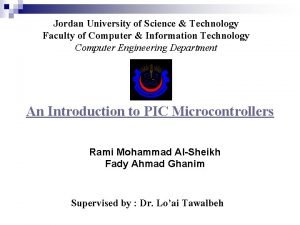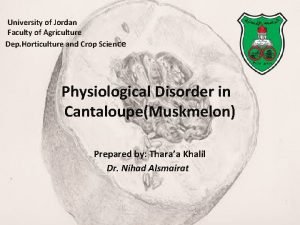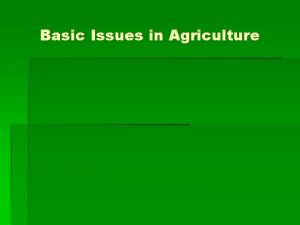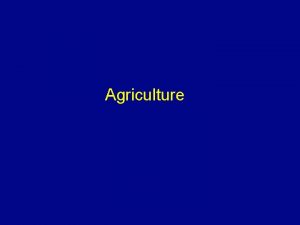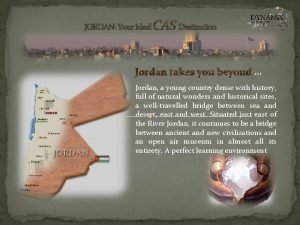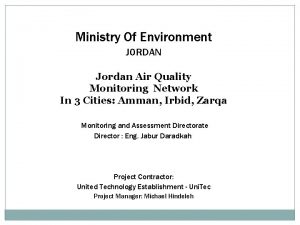The university of Jordan The Faculty of Agriculture





















- Slides: 21

The university of Jordan. The Faculty of Agriculture. Major of horticulture and crop since. Physiological disorders of citrus Student name: Farah Al-asadi Student ID: 0101285 Instructor : Dr. Nihad Alsmirat 1

Physiological disorders: The breakdown of tissue that is not caused by invasion by disease causing organisms or by mechanical damage. Physiological disorders caused by: 1 - postharvest factors. 2 - preharvest factors. 2

Physiological disorders of citrus: 1 - Albedo breakdown or creasing: Creasing is a major rind disorder of mature navel oranges in particular, but other fruits can be affected. It shows up as an irregular pattern of grooves and furrows in the rind, and is worse on the shaded side of the fruit. Creasing is caused by excessive loss of cohesion between albedo cells (the white layer under the skin) stressed by expansion of the pulp. 3

4

* Factors that may contribute are : -rind mineral levels (e. g. low calcium or high magnesium). -rootstock (higher incidence on rough lemon). -water relations. -tree age. -nutritional conditions. -tree health. *Creasing can be reduced with pre-harvest sprays of gibberellic acid as well as calcium sprays. 5

2 -Dry fruit or granulation: *Granulation is a condition in which the juice sacs shrivel because of gel formation. *It is often associated with fast growth. *It occurs more in large fruit, on young trees, in humid climates and on trees growing on sandy soils. 6

7

*On oranges it is commonly seen on young, vigorously growing Valencia orange trees on rough lemon rootstocks. *On Imperial mandarins, granulation also leads to low juice levels and loss of taste. * To minimize the dryness, sufficient water and correct nutrition should be applied, and fruit should be harvested early. 8

3 -Frost injury: *Frost injury usually occurs after nights with clear skies and little wind causing temperatures below minus 2. 2 o. C for more than 4 hours. *Damaged fruit may show drier juice sacs and separated segments without injury to the rind. 9

10

Frost injury can be prevented through: -Selection of warmer planting sites (elevated ground where cold air can drain away). -selection of more cold tolerant scion/rootstock combination. -wrapping the trunks of young trees. -supplying sufficient water to the roots and turning on overhead reticulation during periods of frost. 11

4 -Fruit splitting: *Fruit splitting is often seen in navel oranges, lemons and other citrus fruits when temperatures drop and relative humidity increases with the approach of winter. Splits occur longitudinally starting at the navel end, where the rind is thinnest. *Fruit splitting might be caused by great climatic and soil moisture irregularities. It has been speculated that internal pressure developed by the pulp causes the rind to split. 12

13

*Regular application of fertilizer and water to provide smooth, uninterrupted growth might reduce the problem. *it can be minimized by early picking of fruits soon after maturity. 14

5 -Nutrient deficiencies: *Citrus trees are demanding feeders and are prone to many disorders related to mineral nutrition. On the sandy soils of the metropolitan area, citrus suffer frequently from deficiencies of nitrogen, magnesium, zinc, manganese, iron and copper. *Citrus species are also sensitive to an excess of certain elements in the soil or the irrigation water, especially chloride, sodium, boron and manganese, which can injure the tree. 15

16

*In the home garden this can be easily rectified by the monthly application of a complete fertilizer (1 handful per m 2) to the area covered by the canopy. Make sure the complete fertilizer contains magnesium and all essential trace elements. 17

6 -Oleocellosis: *Oleocellosis is a skin injury caused by oil released from the oil glands in the skin after they have ruptured. The damage can be caused by physical means (poor handling or abrasion) or climate. *The symptoms are greenish or brownish, firm, irregular patches or spots on the skin. *Damaged areas typically darken and become sunken with time. The disorder is sometimes called green spot because the affected areas do not colour at ripening. 18

19

*Oleocellosis can be avoided by careful handling and avoiding harvesting wet fruit early in the morning or after rain. *Best way to reduce its incidence is to cure the fruit overnight at a temperature of 1820 C for 12 -24 hrs, before the fruit is moved from the field. 20

21
 Jordan university of science and technology
Jordan university of science and technology Jordan university of science and technology
Jordan university of science and technology German university jordan
German university jordan Jordan university of science and technology
Jordan university of science and technology University of split faculty of maritime studies
University of split faculty of maritime studies Bridgeport engineering department
Bridgeport engineering department Bridgeport university computer science
Bridgeport university computer science Hubert kairuki memorial university faculty of medicine
Hubert kairuki memorial university faculty of medicine Semmelweis university faculty of medicine
Semmelweis university faculty of medicine King abdulaziz university faculty of medicine
King abdulaziz university faculty of medicine Fsu cybersecurity major
Fsu cybersecurity major Mendel university - faculty of business and economics
Mendel university - faculty of business and economics Singularity university faculty
Singularity university faculty Agnes csaki semmelweis
Agnes csaki semmelweis Ascaris lumbricoides ova
Ascaris lumbricoides ova Feup university of porto
Feup university of porto Webkredit cuni
Webkredit cuni Faculty of veterinary medicine cairo university logo
Faculty of veterinary medicine cairo university logo Faculty of law of the university of zagreb
Faculty of law of the university of zagreb University of montenegro faculty of law
University of montenegro faculty of law University of kragujevac faculty of technical sciences
University of kragujevac faculty of technical sciences University of cologne faculty of management
University of cologne faculty of management
